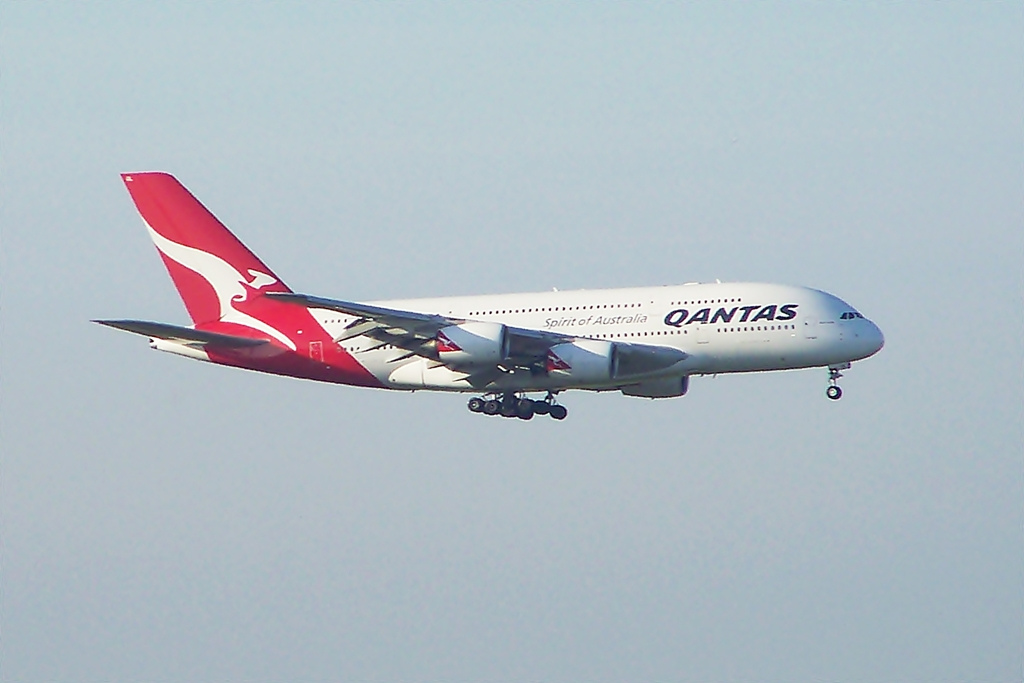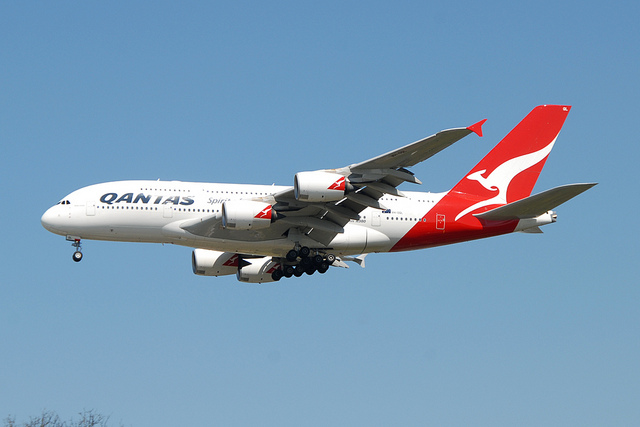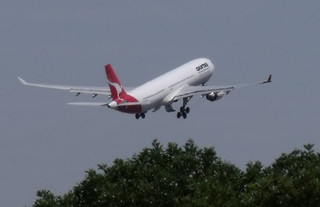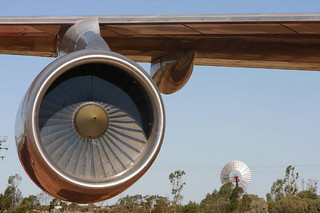Qantas A388 at Dubai on Mar 28th 2014, engine automatically shut down in flight
Last Update: April 18, 2017 / 13:51:23 GMT/Zulu time
Incident Facts
Date of incident
Mar 28, 2014
Classification
Incident
Airline
Qantas
Flight number
QF-9
Departure
Dubai, United Arab Emirates
Destination
London Heathrow, United Kingdom
Aircraft Registration
VH-OQL
Aircraft Type
Airbus A380-800
ICAO Type Designator
A388
The airline confirmed a #3 engine fault indicated by the instruments prompted the crew to return to Dubai.
A replacement Airbus A380-800 registration VH-OQI reached London with a delay of 14.5 hours.
On Apr 18th 2017 the United Arab Emirates GCAA released their final report concluding the probable causes of the incident were:
The Air Accident Investigation Sector determines that the cause of the inflight engine shutdown was the mechanical damage of the step aside gear box (SAGB) that had resulted in a loss of drive to the external gear box (EGB).
The loss of drive resulted in the uncommanded shutdown of the engine along with the disconnection of the fuel pump fuel, oil pumps and generators, which were driven from the EGB. The primary root cause was insufficient clamping load to prevent relative movement between the SAGB driven bevel gear shaft lower support bearing and the bearing support housing.
THe GCAA reported the aircraft was climbing through 2000 feet out of Dubai when the crew received an ECAM message "ENG FAIL" indicating the #3 engine had failed. The engine had shut down without being commanded to do so although all indications had been normal prior to the shut down. The crew stopped the climb at FL060, the crew attempted to re-start the engine without success, the crew observed no rotation of the high pressure spool. The crew therefore initiated a return to Dubai for a safe landing. Metallic particles were found on the engine's master chip detector confirming the engine had suffered an internal failure.
The GCAA reported that the #3 engine had undergone an engine shop visit for removal of the high pressure turbine due to expiry in June 2013, where the SAGB bearing support was found damaged and was replaced. Following the shop visit the engine had operated for 2,224 hours in 198 flight cycles, all on the occurrence aircraft.
The GCAA analysed:
Hardware was examined in the laboratory at the SAGB manufacturer (Avio Aero). A cracked lower bearing support from another engine was examined by Avio and Rolls-Royce in the Rolls-Royce laboratory. These examinations identified that crack had initiated from stress concentration features resulting from the wear step generated on the lower bearing support. Examination of the fracture surface in the scanning electron microscope (SEM) identified characteristic of propagation under a high cycle fatigue mechanism.
A stress review between Rolls-Royce and Avio Aero was performed. The difference between starting loads and engine running loads was agreed. Analysis of the bolted joint at the interface of the bearing with the lower bearing support found that the original, specified bolt torque did not produce a sufficient clamping load to prevent relative movement between the components during engine running. This was identified as the primary root cause.
The Angled Drive Shaft (ADS) imbalance condition was concluded to exacerbate the movement and was therefore a contributory factor that influenced the rate of wear. Any out-of-tolerance radial run-out of the ADS would also influence the out-of-balance at high shaft speeds and was therefore concluded to be contributory factor.
Further analysis, with increased bolt torque applied, demonstrated that the increased clamping load at the joint would prevent movement when a correctly balanced and in-tolerance ADS is installed. The analysis also indicated that there was reserve margin in the current design under these conditions.
The major quality investigation at Avio Aero identified the reason for the ADS unbalance condition. This resulted in effective, remedial processes being incorporated that addressed the imbalance condition and identified shafts with unacceptable radial run-out.
Incident Facts
Date of incident
Mar 28, 2014
Classification
Incident
Airline
Qantas
Flight number
QF-9
Departure
Dubai, United Arab Emirates
Destination
London Heathrow, United Kingdom
Aircraft Registration
VH-OQL
Aircraft Type
Airbus A380-800
ICAO Type Designator
A388
This article is published under license from Avherald.com. © of text by Avherald.com.
Article source
You can read 1 more free article without a subscription.
Subscribe now and continue reading without any limits!
Read unlimited articles and receive our daily update briefing. Gain better insights into what is happening in commercial aviation safety.
Send tip
Support AeroInside by sending a small tip amount.
Related articles
Qantas A388 near Fiji on Oct 3rd 2014, dual fuel pump failure
A Qantas Airways Airbus A380-800, registration VH-OQL performing flight QF-7 from Sydney,NS (Australia) to Dallas Ft. Worth,TX (USA), was enroute…
Qantas B738 near Auckland on Sep 26th 2025, cargo fire indication
A Qantas Boeing 737-800, registration VH-VZE performing flight QF-141 from Sydney,NS (Australia) to Auckland (New Zealand), was descending towards…
Alliance E190 near Darwin on Sep 22nd 2025, loss of cabin pressure
An Alliance Airlines Embraer ERJ-190 on behalf of Qantas, registration VH-XVU performing flight QF-1889 from Darwin,NT to Cairns,QL (Australia), had…
Qantas A333 at Melbourne on Aug 10th 2025, hydraulic problems
A Qantas Airbus A330-300, registration VH-QPJ performing flight QF-29 from Melbourne,VI (Australia) to Hong Kong (China), was climbing out of…
Qantas B738 at Brisbane on May 4th 2024, severe turbulence injures 3, 4 people out of seats on landing
A Qantas Boeing 737-800, registration VH-VYK performing flight QF-520 from Sydney,NS to Brisbane,QL (Australia) with 143 passengers and 6 crew, was…
Qantas A332 over Pacific on Dec 3rd 2024, sparks seen from engine
A Qantas Airbus A330-200, registration VH-EBQ performing flight QF-16 from Los Angeles,CA (USA) to Brisbane,QL (Australia) with 149 passengers and 9…
Newest articles
India B788 at Ahmedabad on Jun 12th 2025, lost height shortly after takeoff, no thrust reported
An Air India Boeing 787-8, registration VT-ANB performing flight AI-171 from Ahmedabad (India) to London Gatwick,EN (UK) with 230 passengers and 12…
Saudia B763 at Madinah on Jan 5th 2014, right main gear up landing
A Saudi Arabian Airlines Boeing 767-300, registration HS-BKE performing flight SV-2841 from Mashad (Iran) to Madinah (Saudi Arabia) with 299…
Subscribe today
Are you researching aviation incidents? Get access to AeroInside Insights, unlimited read access and receive the daily newsletter.
Pick your plan and subscribePartner

ELITE Simulation Solutions is a leading global provider of Flight Simulation Training Devices, IFR training software as well as flight controls and related services. Find out more.
SafetyScan Pro provides streamlined access to thousands of aviation accident reports. Tailored for your safety management efforts. Book your demo today
AeroInside Blog
Popular aircraft
Airbus A320Boeing 737-800
Boeing 737-800 MAX
Popular airlines
American AirlinesUnited
Delta
Air Canada
Lufthansa
British Airways








